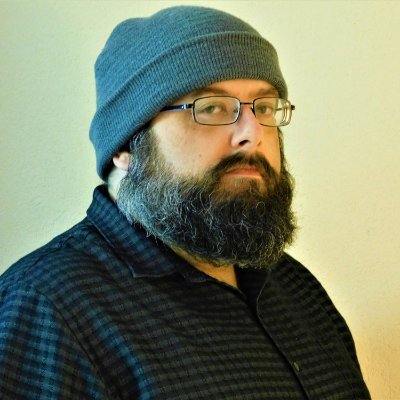Death's Head: From "throwaway" Transformers character to Marvel cult hero
Talking with Simon Furman, Kieron Gillen, and more about Death's Head

Death's Head may not look like your typical Marvel hero, but if you‘re a fan, that's part of his charm. This cult-favorite hero from the Marvel UK line is a rutty robotic bounty hunter that is one-part 2000AD, one-part Transformers, and one-part traditional Marvel hero. He's a junkyard Voltron and that's what makes him special. Not bad for what was originally a "throwaway character" as described by his own co-creator.
First dreamt up by legendary Transformers writer Simon Furman in 1987 as an incidental character for Transformers UK, Death's Head was only taken seriously when artist Geoff Senior turned in his rendition of the character. Furman knew then they might be on to something.
"He started life as a fairly generic bounty-hunter in the story designed to echo the spaghetti westerns (particularly those directed by Sergio Leone)," Furman tells Newsarama. "Some of the stuff was there from the start: the interchangeable weapons, the dislike of being called a bounty-hunter, but when we saw Geoff Senior's art (pretty much all I said was he has an animal skull-style head) I went back into the script (which I rarely ever did back in the day) and retooled his dialog to give him a more distinct and humorous personality."
This added attention to what was originally a "throwaway character" made Furman and Marvel UK staffers take notice, and reconsider the original plan to introduce him in Transformers UK. The fact that Transformers UK was a licensed title meant that any character who debuted in the licensed title became the property of the licensor – in this case, Hasbro – rather than the publisher.
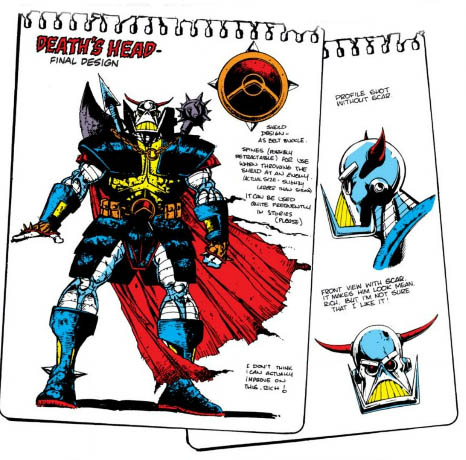
"So we rush-produced this one-page Death's Head story called 'High Noon, Tex.'" reveals Furman. "In fact, it was so rush-produced that Geoff was still drawing the subsequent Transformers UK story, so we had to draft in a new/young artist who'd just started showing his samples around the Marvel UK offices. I forget his name. Bryan something? Oh yeah. Hitch, Bryan Hitch."
That's the same Bryan Hitch who became one of the industry's top superhero artists with work on The Ultimates, The Authority, and Justice League.
Marvel UK's hurried attempt to retain Death's Head as their own went off without a hitch, with the 'High Noon, Tex' story being slipped into the back of several of Marvel UK's releases that month, predating the release of Transformers UK #117 and securing the copyright for Marvel. But this appearance of a new, original character square into a leading role in the Transformers UK title was a revelation for that series' fans. Although the title might be dismissed by some, it was a major part of the British comics scene in its time - and went on to make Death's Head the breakout new Marvel character of 1987, as documented in our Marvel Yearbook for the '80s.
Get the best comic news, insights, opinions, analysis and more!
"The British Transformers comics are very much a generational thing for a certain strain of Brit creators, I fear," says British comics writer Kieron Gillen. "If Impactor was our Jean Grey, Death's Head was our Wolverine."
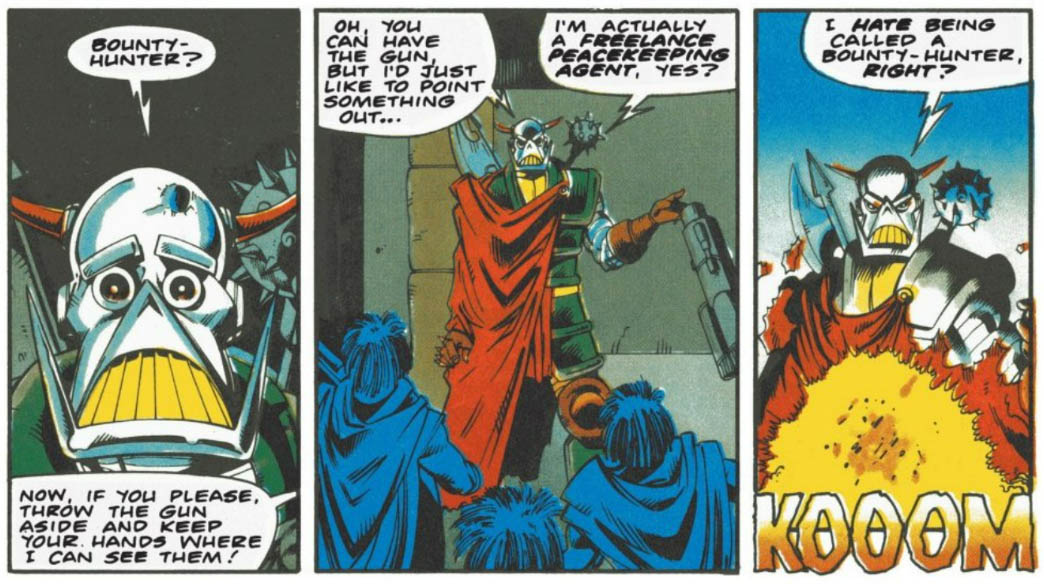
After that starring role in Transformers UK alongside Rodimus Prime and Galvatron, the character went out into other titles in Marvel UK's line – even appearing in a Doctor Who story. Death's Head didn't make his proper Marvel debut until a few months later inside Furman's futuristic superhero team book Dragon's Claw, then Marvel UK's flagship in-house title, and then earning his own solo series.
"I loved seeing how he then cascaded through the Marvel Universe, but that early Furman incarnation was a joy in lots of ways," Gillen explains. "And he has a removable hand. That's always fun. Who didn't love Death's Head? He was great."
The Death's Head solo series earned high praise from fans as well as Stan Lee himself when released in 1988, but the series was cut short after its 10th issue with the publisher citing distribution and formatting problems with the American-size format versus the larger British comic periodicals. But just months after the title's cancellation, newly hired editor Paul Neary commissioned Furman and Senior to work on a new Death's Head series. But Neary had second thoughts about the character's design, explaining that he thought it wouldn't work on the shelves in 1992 with the works of Jim Lee, Todd McFarlane, and Rob Liefeld dominating comics.
So in comes Liam Sharp.
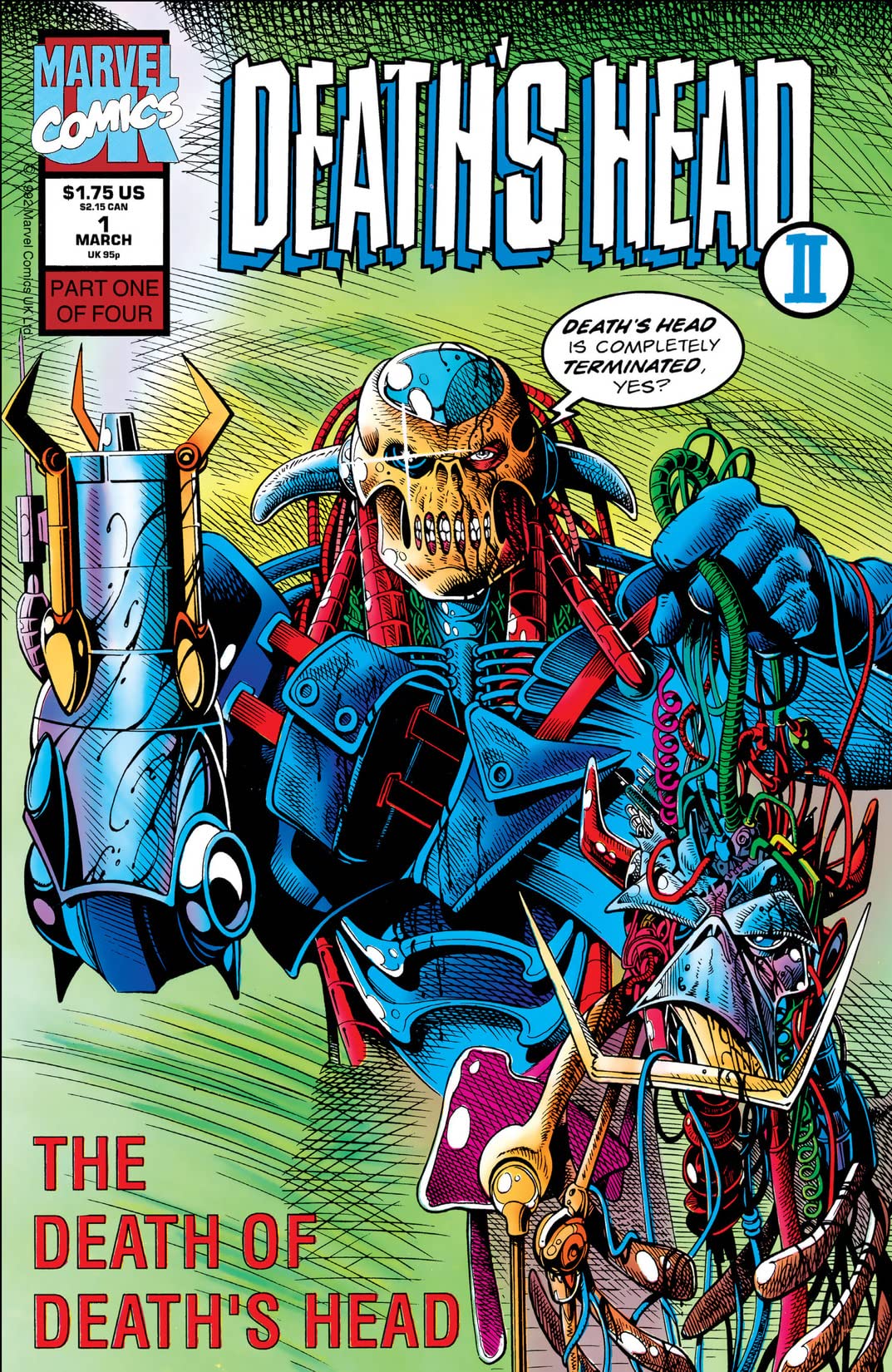
"I sent Paul a drawing via FAX of a new Death's Head which had a 'Predator meets Terminator' feel, saying I always felt Death's Head should look like this," says Sharp, who at the time was a newcomer to comics. "Paul loved it and it eventually became the basis of the first cover to the new series. Paul called a halt to everything, pulling poor old Simon and Jeff off the book - which naturally I felt terrible about!"
This new iteration of Death's Head - succinctly titled Death's Head II - was crafted to take advantage of the more 'extreme' art style washing over comics in 1992, and Neary encouraged Sharp to harness that in this series – but with his own homegrown spin.
"With Paul's guidance it became clear that my own style was very compatible with the Image look, but I added a bit of UK darkness that had its roots firmly in 2000AD," says Sharp. "Paul then brought in Dan Abnett to write and I got Andy Lanning in to ink me - we had shared a studio in Islington, London, for years and were old friends. Dan and I talked a lot about the story - Paul was very keen to include the artist in the creation of plot points, etc., and which guest characters they would like to bring onboard. We had a lot of fun putting our future Avengers together I recall!"
This new Death's Head crisscrossed the globe and jumped across the pond, doing crossovers with the Avengers as mentioned as well as the X-Men and others, but it too eventually dried up as the Marvel UK was downsized and ultimately closed. Sharp partnered with Bryan Hitch in 2007 in an attempt to do an Ultimate Death's Head series for Marvel that was rebuffed by the publisher.
For almost a decade Death's Head's appearances in comics were slim to none, but in 2005 he won an online poll put out by Marvel for a spot in Marvel's then-revived Amazing Fantasy title. Death's Head was then remade a third time, but this time Marvel editor Mark Paniccia asked the character's original writer Simon Furman to be the one doing the revamping. This new iteration, dubbed Death's Head 3.0, had some surface similarities to the original incarnation but even Furman admits the character didn't work.
"I always thought it strange that poll was to bring back one character and what readers got was another entirely," Furman said in an interview with the website Starburst. "It was part of my motivation to try and somehow meld the two together. It's a shame. I'd have much rather done the original."
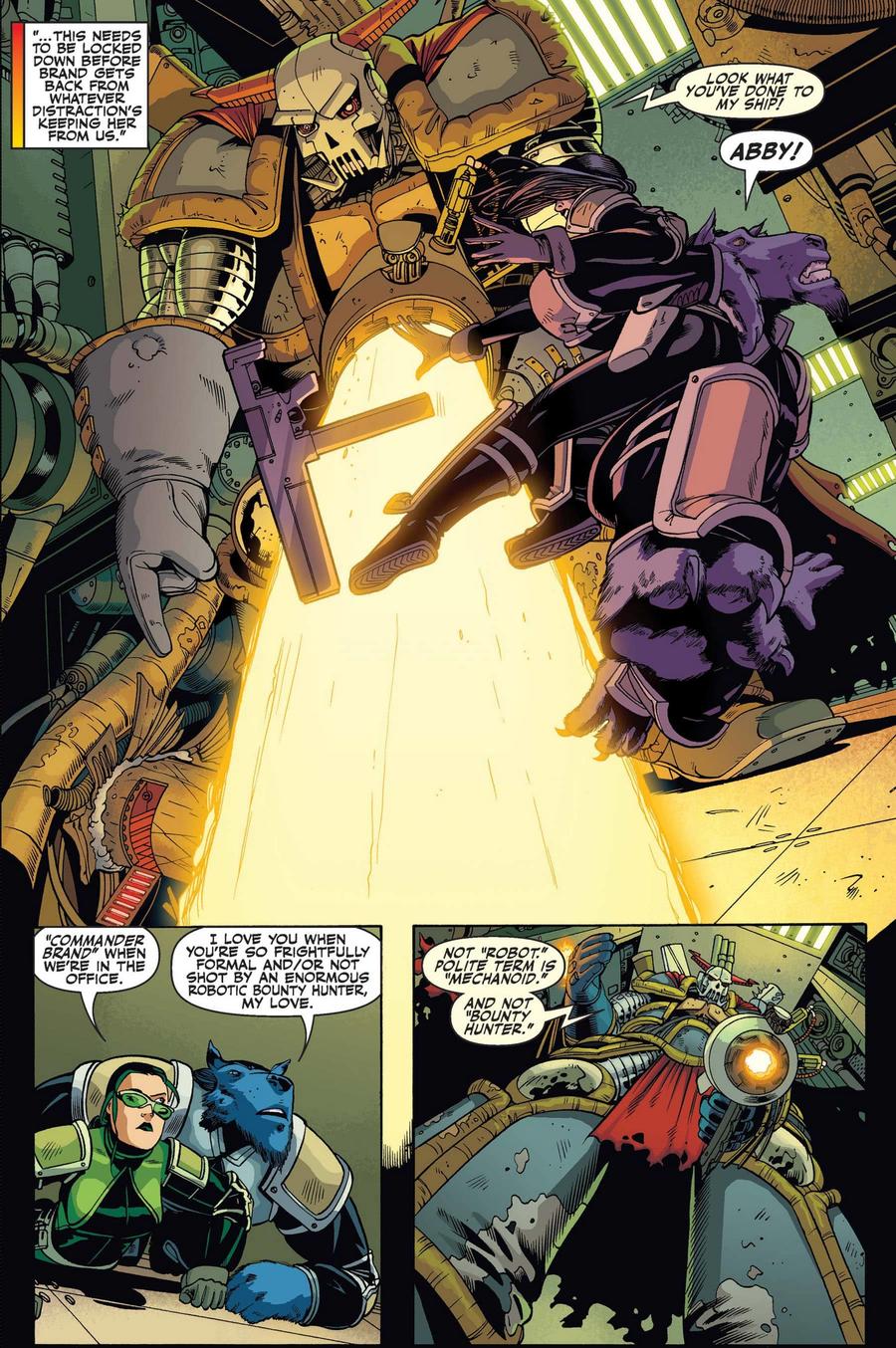
After this brief 2005 return, Death's Head and all of his incarnations fell largely into disuse with only brief cameos such as in Captain Britain & The M.I. 13 and in Gillen's 2009 series SWORD. But Gillen, a childhood fan of the character if you recall, had bigger plans for the bounty hunter and thought enough to ask Furman for his blessing in bringing him back.
"It was really nice of Kieron to sound me out about re-using Death's Head (and the original to boot)," Furman says. "Not that my yea or nay would have impacted on Marvel policy one jot, but it was still nice."
With all the various iterations of Death's Head floating around, bringing him back – in his original form no less – might be wading into some complicated continuity but Gillen wasn't concerned.
"Death's Head is a dimension skipping time-traveling robot. He's probably a walking paradox several times over," Gillen points out. "Part of the joy of Death's Head is that he really doesn't seem to care."
Gillen used him in his 2012 - 2014 Iron Man run in a key role for Tony Stark's extraterrestrial adventures, and the character appeared soon after in the brief Marvel UK revival Revolutionary War.
The character recently returned in a 2018 four-issue Death's Head series by Tini Howard and Kei Zama, with the robo-bounty hunter going through an existential crisis when he realizes as a robot, there's always a newer model.
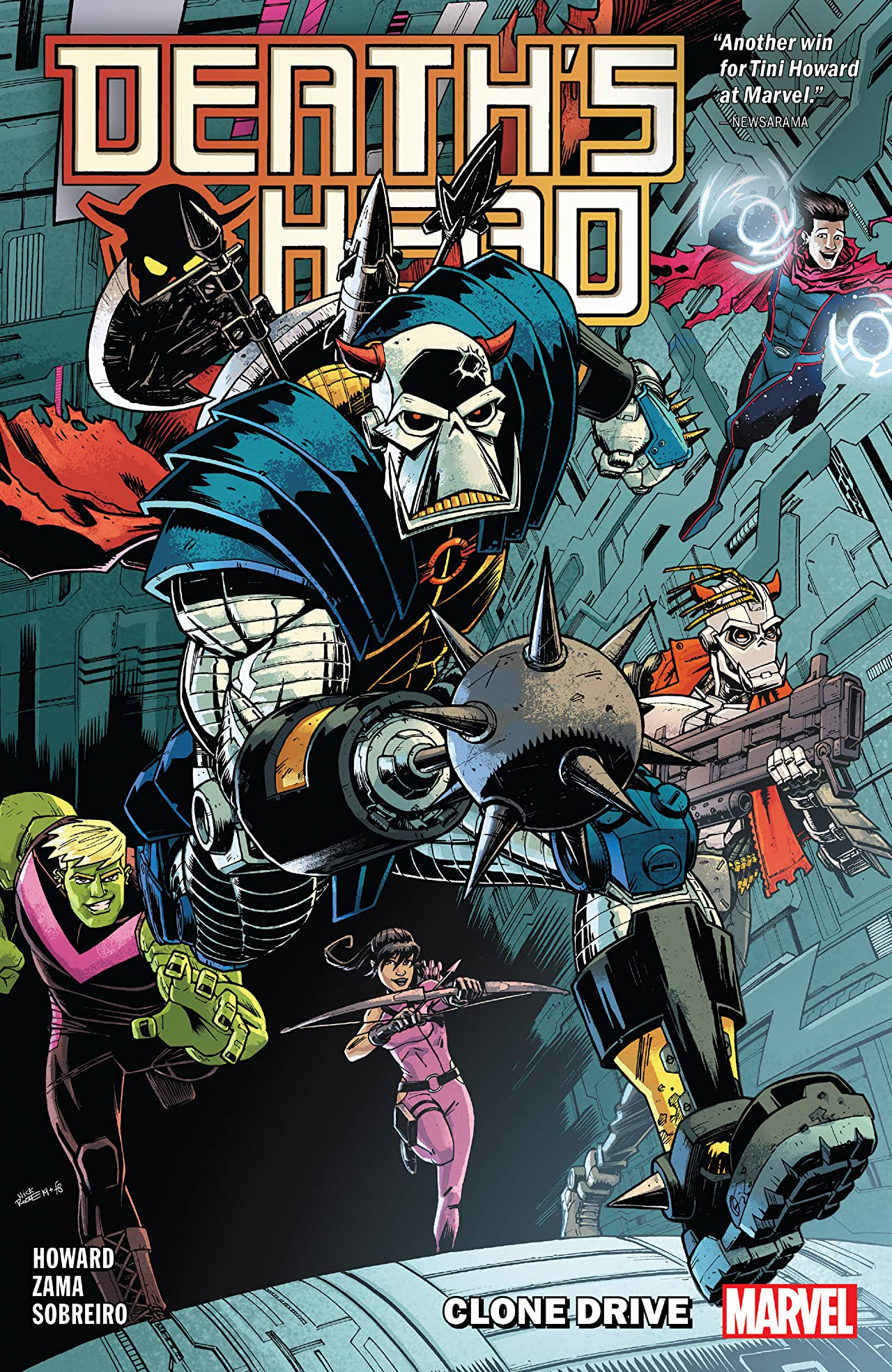
"So I was drawn to Death's Head as a character that looks super powerful and tough but is... big. Clunky. Breaks easily. And his whole job is apprehending people for money, and if people with better tech surpass you in that, you end up... kind of broke, yes?" Howard tells Marvel.com. "Oh, also he's a GREAT BIG BOY with weapons. He has a Swiss Army knife for an arm that takes different attachments. Who wouldn't love that guy?"
Despite his frequent deaths and possible leanings towards being obsolete, Death's Head numerous revivals attest to the genuine interest the character has achieved in fans and fans-turned creators. Newsarama went back to the source, Simon Furman, and asked why he thought Death's Head has stuck with people despite an uneven track record.
"I think it's because he's such a wonderfully un-shaded character. He really just is what he is," says Furman. "And doesn't try and hide it or dress it up in any way. He kills people/robots/aliens for money. He's totally about the bottom line. No room for rage or revenge or heroics. Where's the profit in that, eh? But this cold, cynical side is leavened by this big seam of dark, dark humor and strange personality/dialog tics. Without those, he's just another badass mech.
"Death's Head comes out of this UK-comics sensibility of extreme violence that masks a kind of social satire (the kind of '80s 'Greed is Good' credo was what we were getting at). And yet he's also very U.S.-comics friendly, and fits really well in the world of Marvel heroes (be they Earth-based or cosmic). He just has the best of all worlds. Really all-purpose."
Check out all the breakout new characters of that decade with Marvel Yearbook: the '80s.
Chris Arrant covered comic book news for Newsarama from 2003 to 2022 (and as editor/senior editor from 2015 to 2022) and has also written for USA Today, Life, Entertainment Weekly, Publisher's Weekly, Marvel Entertainment, TOKYOPOP, AdHouse Books, Cartoon Brew, Bleeding Cool, Comic Shop News, and CBR. He is the author of the book Modern: Masters Cliff Chiang, co-authored Art of Spider-Man Classic, and contributed to Dark Horse/Bedside Press' anthology Pros and (Comic) Cons. He has acted as a judge for the Will Eisner Comic Industry Awards, the Harvey Awards, and the Stan Lee Awards. Chris is a member of the American Library Association's Graphic Novel & Comics Round Table. (He/him)
